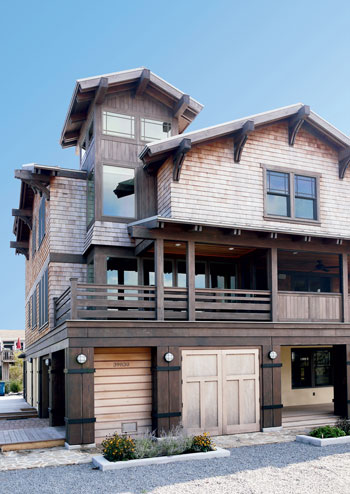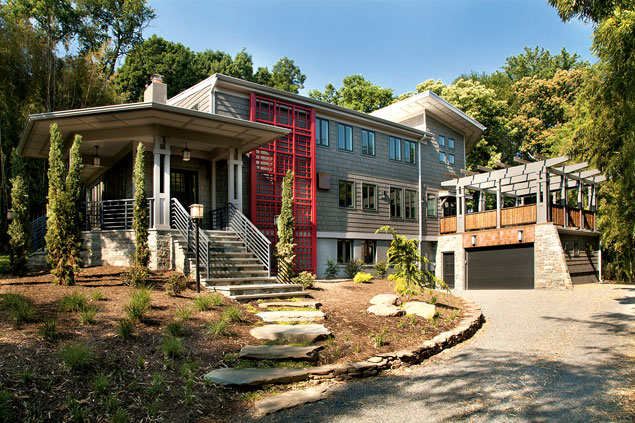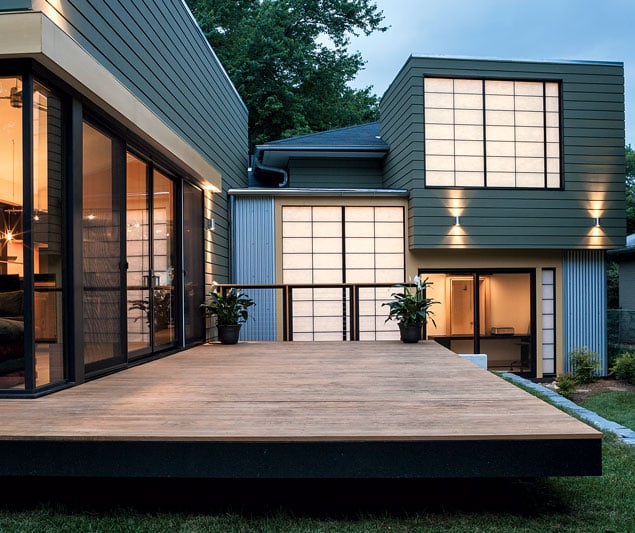Adina and Mike Liuzzo call themselves “accidentally sustainable.” They didn’t set out to be green seven years ago when they asked Silver Spring architect Amy Gardner to renovate their Bethesda split-level—they admired her work but had no idea she was the University of Maryland’s lead faculty adviser in the biennial Solar Decathlon, an event sponsored by the Department of Energy in which college teams compete to design and build the most energy-efficient, affordable, and attractive solar-powered houses.
“This whole sustainable movement was just getting started back then,” Mike Liuzzo says. “We weren’t aware of it.”
In 2013, though, green living is fast evolving from a curiosity to a new standard of homebuilding and renovation. A combination of stricter codes and increased awareness—among consumers and builders alike—is producing a new crop of homes that are more comfortable to live in and require dramatically less energy.
The Liuzzos merely wanted to update their home. And with a 1957 house that had aging heating and cooling systems, outdated appliances, and single-pane metal casement windows, they wanted the result to be more energy-efficient. “The things we wanted, we didn’t know they were sustainable,” Mike Liuzzo says. “To us, they were common sense.”
Along the way, Gardner showed the couple other options from her work with the decathlon: “passive” design that captures the winter sun to help heat the house while shading it from the summer sun, new methods of insulation, and sustainable materials such as bamboo floors and countertops made from recycled paper. “It was an educational process for us,” Adina Liuzzo says. “We realized that we can do this.”
Since then, Gardner says, there’s been a sea change in interest and awareness on the part of consumers and homeowners. Going forward, “it’s the next generation that’s going to demand it,” says Falls Church builder Yuri Sagatov, referring to clients in their late twenties and thirties who see green construction as simply part of the deal.
Green building products are also becoming much more accessible and affordable in the long run.
Bethesda architect Jim Rill can attest to that: Highly efficient spray-foam insulation used to be an upgrade in his projects; now it’s standard. Energy-saving light bulbs, faucets, and toilets are also par for the course.
• • •

Some of the more advanced green systems do still reside in the realm of true believers, for whom green is a way of life and not just a money-saving issue.
Rill recently designed a summer house in Bethany Beach, Delaware, for Paul and Heather Haaga, who live near Pasadena, California. Heather Haaga says she and her husband came into the project extremely eco-conscious: “No one in this day and age can’t be thinking about the green possibilities.”
She started with Delaware builder Dean Pusey, who has a reputation for using insulated concrete forms—essentially foam panels with a cavity in the middle, into which concrete is poured after the panels are installed. The results are 11-inch-thick walls that have some of the highest insulation values on the market but make the structure stand up against fire and high winds.
The Haagas also opted to include geothermal heating and cooling, in which pipes are buried as deep as 300 feet underground, where the temperature is constant, and water is pumped through the pipes to provide even temperatures throughout the house. Neither method is inexpensive, she says, but “we’re in this house forever, so it was an easy decision.”
Don Wright and Kathryn Palmer, who live in Northwest DC’s Palisades neighborhood, are also reaping the benefits of green investment. Their monthly gas bills are about $15 since they renovated their house three years ago with Chryssa Wolfe and Jake Hanlon of Hanlon Design Build. Like the Liuzzos, Wright and Palmer knew Wolfe and Hanlon’s work from around the neighborhood but didn’t realize all the green aspects of what the firm did.
A new geothermal system that heats the house and the pool, plus spray-foam insulation throughout, keeps the bills extremely low. And the couple can enjoy all the rooms now; before, they couldn’t use some upstairs areas because the old systems didn’t warm or cool them effectively.
• • •

For the most part, consumers are still unaware of their green-building choices.
“There is a lack of interest from most buyers in green issues, which I find kind of surprising,” says Mickie Simpson, a certified Green Realtor with TTR Sotheby’s. Jill Schwartz, a Green Realtor with Long & Foster, agrees: “Nobody ever approaches me and says, ‘I want to buy a green house.’ My career has evolved to educate them and take them through the back door.”
Some builders are teaching their clients by example, upgrading their own homes to illustrate the green possibilities.
Builder John Tabor won an award last year from the National Association of the Remodeling Industry for green construction on his residence. “When clients are dithering about which way to go, I say, ‘This is what we did in our house,’ ” he says, pointing to his reflective roof, geothermal system, and recycled and sustainable materials throughout the house.
Topher Paterno, a former Los Angeles resident who moved to Washington last year to start his green building and furniture-making company, Pazzo Verde, is renovating a rowhouse in Georgetown using eco-friendly products and systems as well as recycled materials from the demolition. He’s also building furniture with the repurposed materials, and he intends to host a green event at his home when it’s completed later this year.
“You still have to sort of stand on a soapbox and point to the big elephant in the room right now,” he says. “The green mindset is not automated yet.”
Regardless, homeowners who are renovating or buyers looking for new home construction in the next several years will be going green whether they intend to or not.
National and local building codes across the country are requiring ever more efficient energy and water consumption as well as higher levels of indoor air quality. That means almost anyone who builds a new home or renovates will have to include basics such as low-flow faucets and toilets plus energy-efficient lighting, appliances, windows, and insulation.
In some jurisdictions, HVAC systems have to maintain a certain air quality. DC, Maryland, and Virginia rank high in eco-friendly codes, says Cliff Majersik, executive director of the Institute for Market Transformation, which helps states and other localities across the nation write and adopt these codes.
“It’s a reality now,” says Stephen Dirks, a builder who also advises companies on how to put green programs into place. “The best news, and why we’re able to catch clients, is that codes are catching up with where we’ve wanted to be for ten years.”
Jennifer Sergent (jennifersergent@verizon.net) is a design writer whose blog, DC by Design, covers interiors and architecture.
This article appears in the April 2013 issue of The Washingtonian.


















